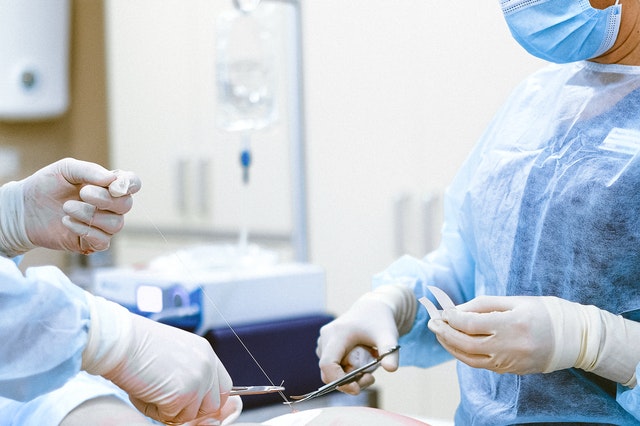Quick search
CTRL+K
Quick search
CTRL+K


Since 2010, the Global Law Experts annual awards have been celebrating excellence, innovation and performance across the legal communities from around the world.
posted 3 years ago
A 30-year-old female presented to an Accident & Emergency Department with abdominal pain. She had been sick for about 12 hours. Investigations revealed an appendicitis.
She was admitted to hospital and consented for a laparoscopic (keyhole) appendectomy, being informed of the risks, including bleeding and infection.
She was given intravenous antibiotics, and the operation was carried out within six hours of her arrival at hospital. Her appendix was noted to be inflamed, as later confirmed by histopathology. It was removed using a diathermy (heat) hook, which was used to cauterise blood vessels going to the appendix. She was also noted to have some adhesions to the anterior abdominal wall, which were taken down by sharp dissection with diathermy scissors.
Postoperatively she was inclined to have a tachycardia, with her pulse remaining around 100 over the next day, before settling to normal. Her blood pressure and temperature remained normal throughout. She was regarded as being fit for discharge after 48 hours, having continued on intravenous antibiotics, and was given a further three days’ oral antibiotics to take home.
Just over 24 hours after she got home, she began to feel sick again, with a raised temperature, and the following day attended a different hospital. Her pulse was 120, her blood pressure slightly low at 105/65, her white count was high, and she was diagnosed as having a septicaemia. A CT Scan showed a collection in her pelvis, thought to represent an infected haematoma (collection of blood). Three hours after arrival at hospital, she was taken to the theatre and underwent an open procedure to remove the infected blood clot and to wash out her abdomen. She had a stormy postoperative period, remaining in hospital for eight days.
She went to her lawyer one month later, stating that the second hospital had indicated that the first hospital had been negligent, and she wished to sue.
A screening perusal of the notes showed no evidence of substandard care on the initial admission. She had been diagnosed and operated on promptly. On balance, the bleeding in her abdomen, which had stopped by the time of her second operation, came from either the takedown of the adhesions or from the diathermy of the blood vessels leading to the appendix. She had been told by a consultant in the second hospital that he believed the use of diathermy was negligent and that the blood vessels should have been clipped or tied.
Medical literature, when discussing the techniques of the surgery, indicates that different centres advocate the different techniques, some for tying or clipping, and others for using diathermy. They also produce their research figures indicating the acceptability of their particular point of view.
From a medico-legal standpoint, there is a clear range of opinions, and both techniques are carried out by reputable institutions with good results, according to the literature. Therefore, given the range of opinion, the use of diathermy could not be faulted in the surgery carried out, the patient was told at the time of consent that bleeding or infection could be an issue (which it could be with either technique), and therefore, there is no indication of substandard surgical care.
This case shows that there is a range of opinion that can be legitimately held in relation to a surgical technique. On the basis of the literature it would not be possible to medically prefer one technique over another, as both were reasonable in the circumstances. The bleeding and subsequent infection was a complication that could arise from either technique.
MDU figures for 2020 show that less than one in six actions in medical negligence actually succeed, with the vast majority failing on the grounds of causation. It must be remembered that subsequence is not the same as consequence.
Initial screening is therefore essential to manage client expectations at an early stage. This avoids unnecessary effort and costs for all concerned. Too many cases are taken to Court with no chance of success. This is stressful for both the client and their legal adviser, and indeed for the medical personnel involved.
For fast and effective screening of all potential medical negligence cases, contact Peyton Medico Legal Services now on +44 (0)28 87724177, or email [email protected]
Author


There are no results matching your search.
Resetposted 13 hours ago
posted 16 hours ago
posted 16 hours ago
posted 17 hours ago
posted 17 hours ago
posted 17 hours ago
posted 17 hours ago
posted 2 days ago
posted 4 days ago
There are no results matching your search.
ResetFind the right Legal Expert for your business
Sign up for the latest legal briefings and news within Global Law Experts’ community, as well as a whole host of features, editorial and conference updates direct to your email inbox.
Naturally you can unsubscribe at any time.
Global Law Experts is dedicated to providing exceptional legal services to clients around the world. With a vast network of highly skilled and experienced lawyers, we are committed to delivering innovative and tailored solutions to meet the diverse needs of our clients in various jurisdictions.